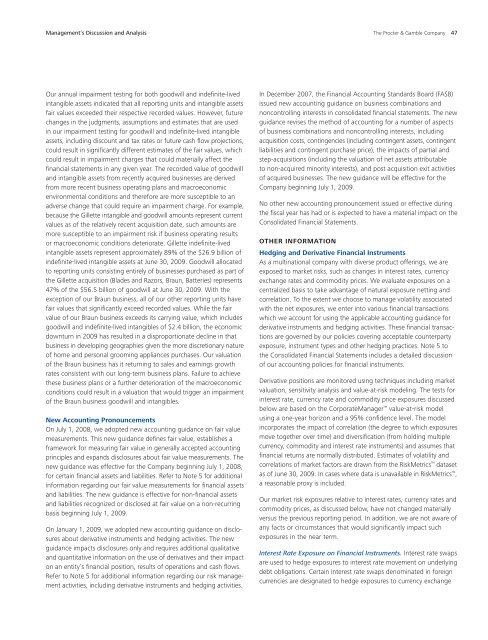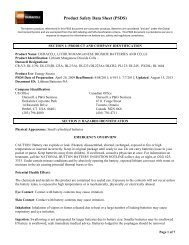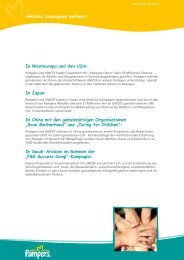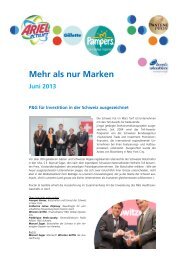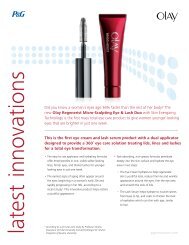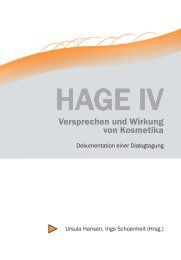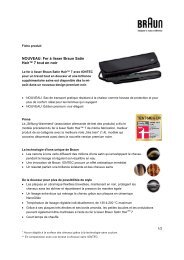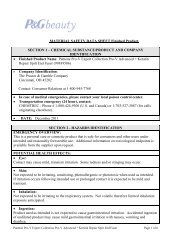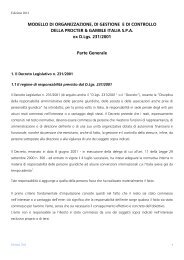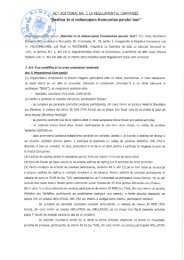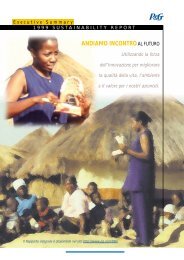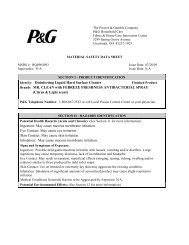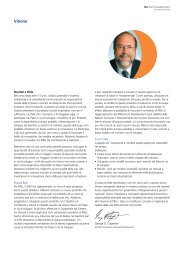P&G 2009 Annual Report – AnnualReports.com - Procter & Gamble
P&G 2009 Annual Report – AnnualReports.com - Procter & Gamble
P&G 2009 Annual Report – AnnualReports.com - Procter & Gamble
Create successful ePaper yourself
Turn your PDF publications into a flip-book with our unique Google optimized e-Paper software.
Management’s Discussion and Analysis The <strong>Procter</strong> & <strong>Gamble</strong> Company 47<br />
Our annual impairment testing for both goodwill and indefinite-lived<br />
intangible assets indicated that all reporting units and intangible assets<br />
fair values exceeded their respective recorded values. However, future<br />
changes in the judgments, assumptions and estimates that are used<br />
in our impairment testing for goodwill and indefinite-lived intangible<br />
assets, including discount and tax rates or future cash flow projections,<br />
could result in significantly different estimates of the fair values, which<br />
could result in impairment charges that could materially affect the<br />
financial statements in any given year. The recorded value of goodwill<br />
and intangible assets from recently acquired businesses are derived<br />
from more recent business operating plans and macroeconomic<br />
environmental conditions and therefore are more susceptible to an<br />
adverse change that could require an impairment charge. For example,<br />
because the Gillette intangible and goodwill amounts represent current<br />
values as of the relatively recent acquisition date, such amounts are<br />
more susceptible to an impairment risk if business operating results<br />
or macroeconomic conditions deteriorate. Gillette indefinite-lived<br />
intangible assets represent approximately 89% of the $26.9 billion of<br />
indefinite-lived intangible assets at June 30, <strong>2009</strong>. Goodwill allocated<br />
to reporting units consisting entirely of businesses purchased as part of<br />
the Gillette acquisition (Blades and Razors, Braun, Batteries) represents<br />
47% of the $56.5 billion of goodwill at June 30, <strong>2009</strong>. With the<br />
exception of our Braun business, all of our other reporting units have<br />
fair values that significantly exceed recorded values. While the fair<br />
value of our Braun business exceeds its carrying value, which includes<br />
goodwill and indefinite-lived intangibles of $2.4 billion, the economic<br />
downturn in <strong>2009</strong> has resulted in a disproportionate decline in that<br />
business in developing geographies given the more discretionary nature<br />
of home and personal grooming appliances purchases. Our valuation<br />
of the Braun business has it returning to sales and earnings growth<br />
rates consistent with our long-term business plans. Failure to achieve<br />
these business plans or a further deterioration of the macroeconomic<br />
conditions could result in a valuation that would trigger an impairment<br />
of the Braun business goodwill and intangibles.<br />
New Accounting Pronouncements<br />
On July 1, 2008, we adopted new accounting guidance on fair value<br />
measurements. This new guidance defines fair value, establishes a<br />
framework for measuring fair value in generally accepted accounting<br />
principles and expands disclosures about fair value measurements. The<br />
new guidance was effective for the Company beginning July 1, 2008,<br />
for certain financial assets and liabilities. Refer to Note 5 for additional<br />
information regarding our fair value measurements for financial assets<br />
and liabilities. The new guidance is effective for non-financial assets<br />
and liabilities recognized or disclosed at fair value on a non-recurring<br />
basis beginning July 1, <strong>2009</strong>.<br />
On January 1, <strong>2009</strong>, we adopted new accounting guidance on disclosures<br />
about derivative instruments and hedging activities. The new<br />
guidance impacts disclosures only and requires additional qualitative<br />
and quantitative information on the use of derivatives and their impact<br />
on an entity’s financial position, results of operations and cash flows.<br />
Refer to Note 5 for additional information regarding our risk management<br />
activities, including derivative instruments and hedging activities.<br />
In December 2007, the Financial Accounting Standards Board (FASB)<br />
issued new accounting guidance on business <strong>com</strong>binations and<br />
noncontrolling interests in consolidated financial statements. The new<br />
guidance revises the method of accounting for a number of aspects<br />
of business <strong>com</strong>binations and noncontrolling interests, including<br />
acquisition costs, contingencies (including contingent assets, contingent<br />
liabilities and contingent purchase price), the impacts of partial and<br />
step-acquisitions (including the valuation of net assets attributable<br />
to non-acquired minority interests), and post acquisition exit activities<br />
of acquired businesses. The new guidance will be effective for the<br />
Company beginning July 1, <strong>2009</strong>.<br />
No other new accounting pronouncement issued or effective during<br />
the fiscal year has had or is expected to have a material impact on the<br />
Consolidated Financial Statements.<br />
OTHER INFORMATION<br />
Hedging and Derivative Financial Instruments<br />
As a multinational <strong>com</strong>pany with diverse product offerings, we are<br />
exposed to market risks, such as changes in interest rates, currency<br />
exchange rates and <strong>com</strong>modity prices. We evaluate exposures on a<br />
centralized basis to take advantage of natural exposure netting and<br />
correlation. To the extent we choose to manage volatility associated<br />
with the net exposures, we enter into various financial transactions<br />
which we account for using the applicable accounting guidance for<br />
derivative instruments and hedging activities. These financial transactions<br />
are governed by our policies covering acceptable counterparty<br />
exposure, instrument types and other hedging practices. Note 5 to<br />
the Consolidated Financial Statements includes a detailed discussion<br />
of our accounting policies for financial instruments.<br />
Derivative positions are monitored using techniques including market<br />
valuation, sensitivity analysis and value-at-risk modeling. The tests for<br />
interest rate, currency rate and <strong>com</strong>modity price exposures discussed<br />
below are based on the CorporateManager value-at-risk model<br />
using a one-year horizon and a 95% confidence level. The model<br />
incorporates the impact of correlation (the degree to which exposures<br />
move together over time) and diversification (from holding multiple<br />
currency, <strong>com</strong>modity and interest rate instruments) and assumes that<br />
financial returns are normally distributed. Estimates of volatility and<br />
correlations of market factors are drawn from the RiskMetrics dataset<br />
as of June 30, <strong>2009</strong>. In cases where data is unavailable in RiskMetrics ,<br />
a reasonable proxy is included.<br />
Our market risk exposures relative to interest rates, currency rates and<br />
<strong>com</strong>modity prices, as discussed below, have not changed materially<br />
versus the previous reporting period. In addition, we are not aware of<br />
any facts or circumstances that would significantly impact such<br />
exposures in the near term.<br />
Interest Rate Exposure on Financial Instruments. Interest rate swaps<br />
are used to hedge exposures to interest rate movement on underlying<br />
debt obligations. Certain interest rate swaps denominated in foreign<br />
currencies are designated to hedge exposures to currency exchange


